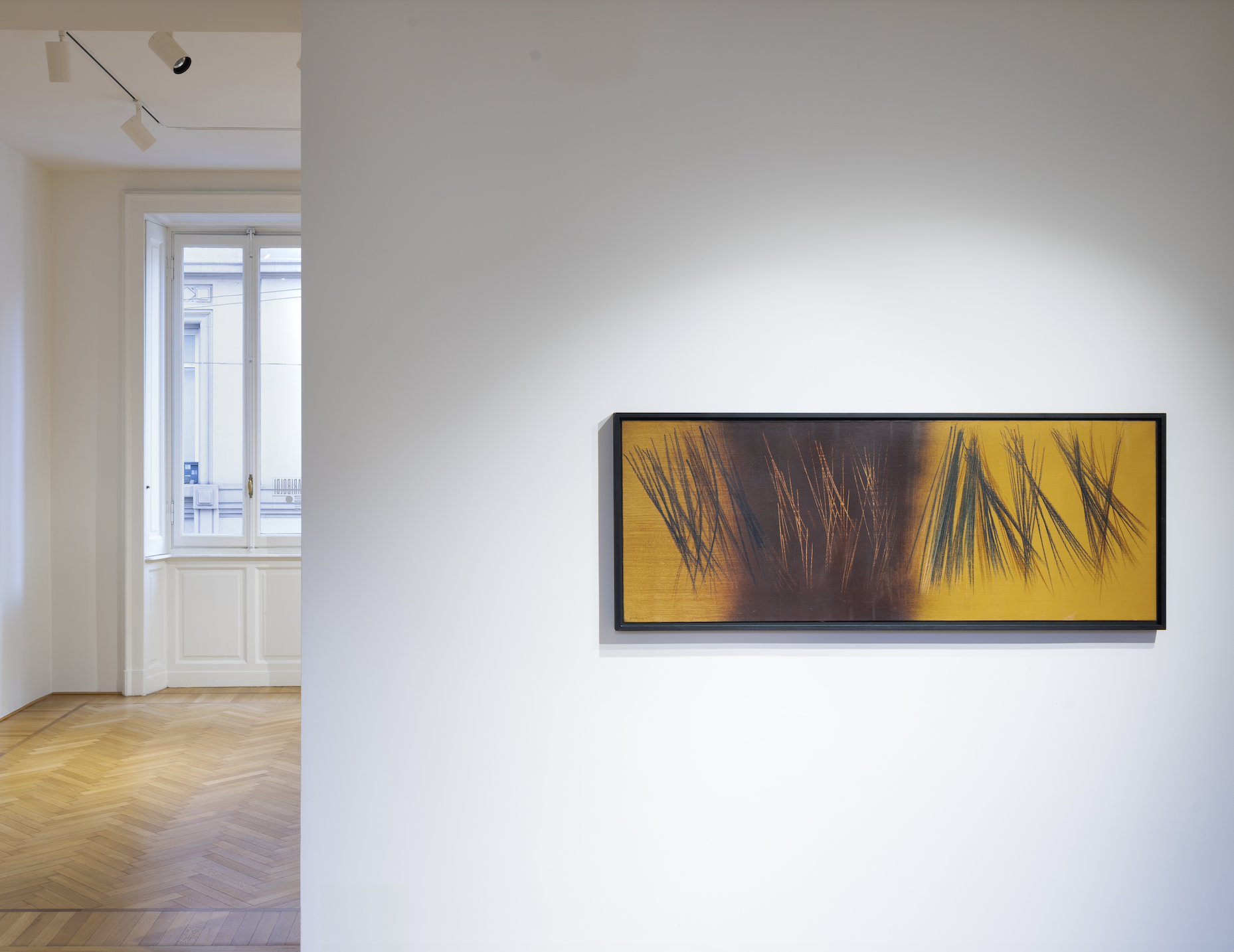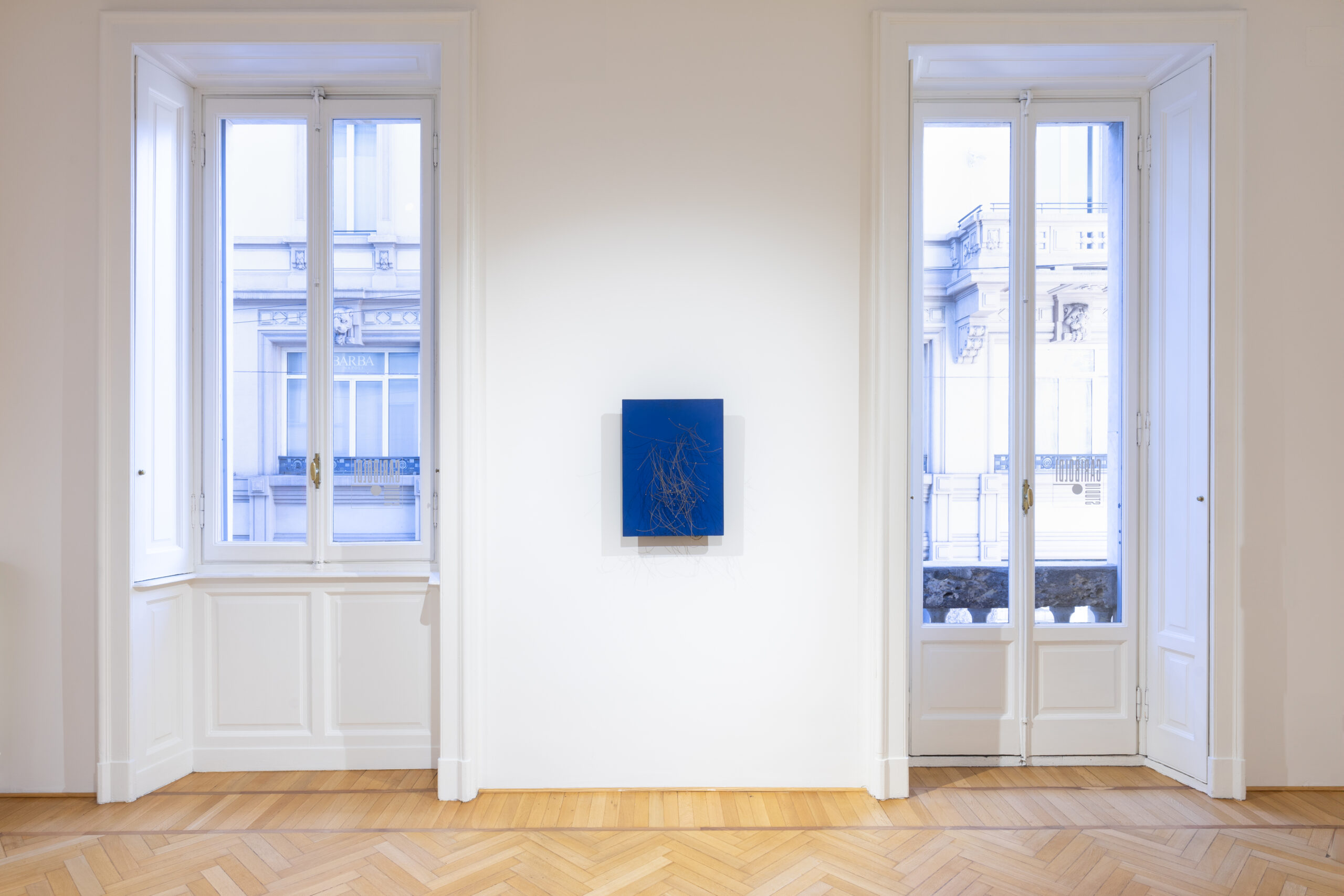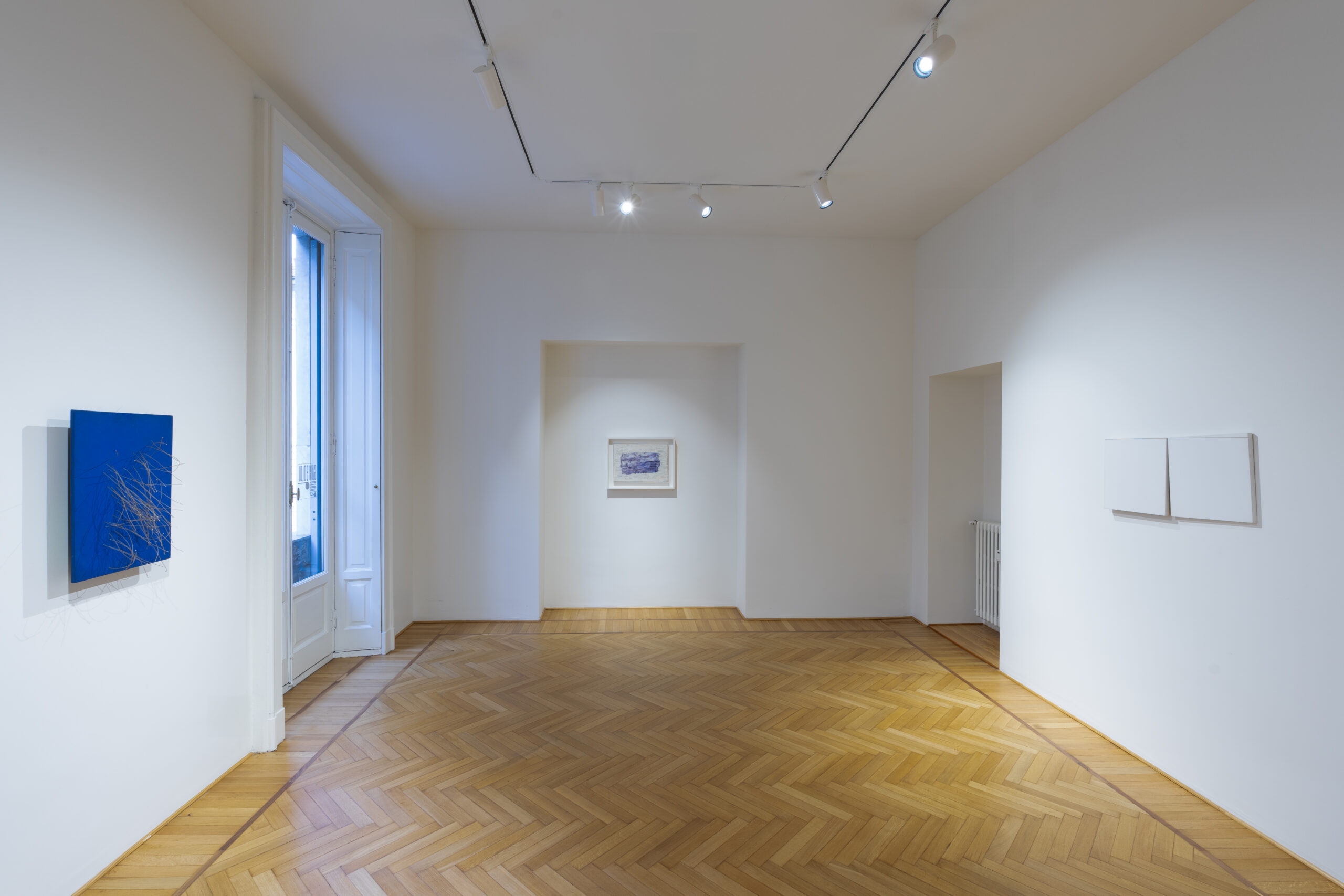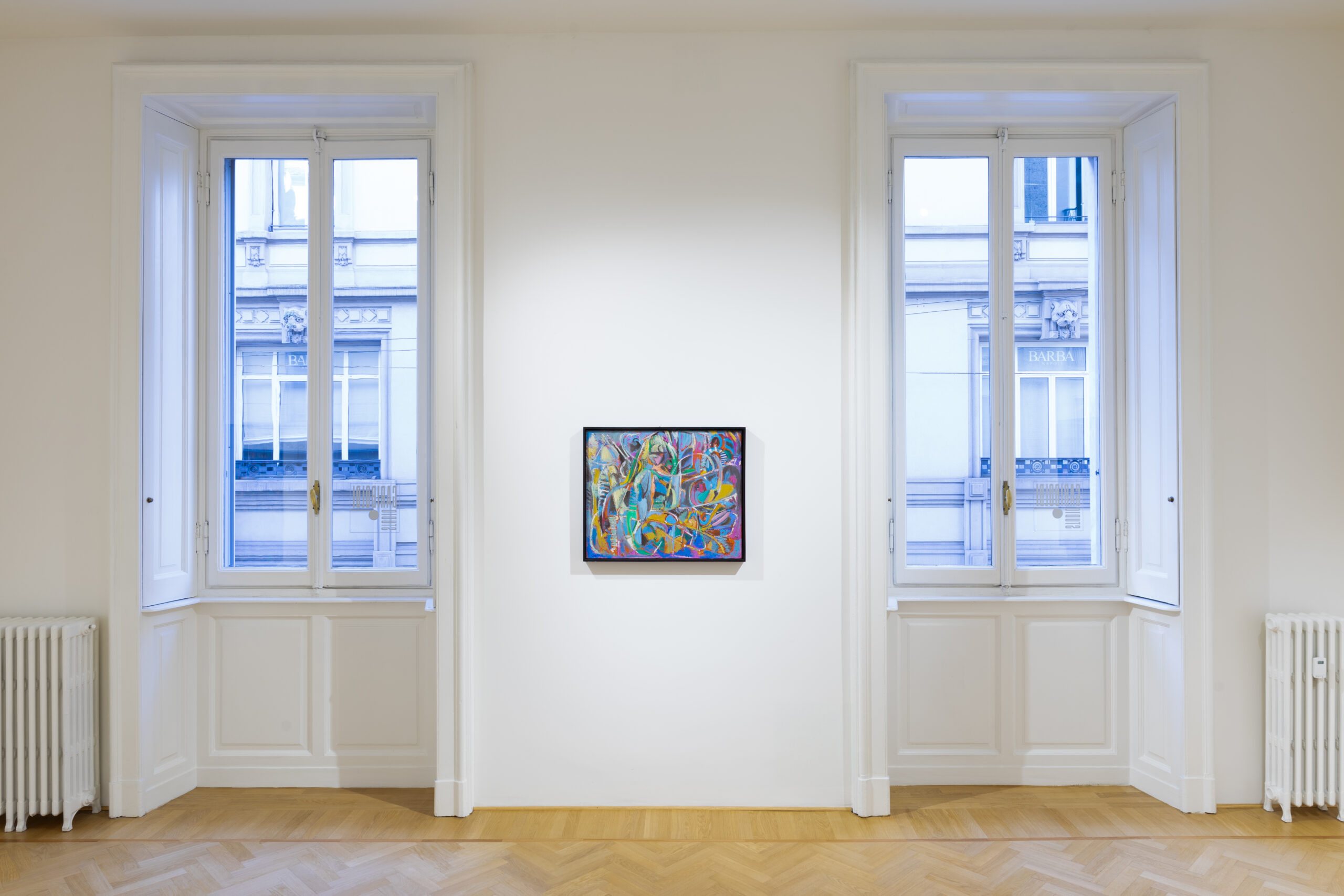RÊVERIES
thirteen French post-war artists
RÊVERIES exhibition leads the viewer into the fascinating world of French informal art. Through the use of colors and shapes, the artists have transformed the canvas into a place of experimentation, where instinct and emotions drive artistic creation.
RÊVERIES offers an intimate look at how the thirteen masters have reinterpreted the very concept of art.
FIRST ROOM
The poetry of abstraction
The first room begins with the work Hauts matin (oil on canvas applied on board, 14.57×32.28 inches) by Jean Messagier, dated 1958, offering a glimpse into his interpretation of spontaneous abstraction. Messagier is a pioneer of lyrical abstraction; his paintings evoke a dreamlike world, as seen in this case with vast, indeterminate expanses of monochromatic color that bear witness to his attention to nature, air, and light. The spontaneous gesturality in the work ‘Hauts matin’ also becomes a form of liberating expression.
The force of the abstract geometry
In dialogue with Jean Messagier’s work, the second painting on display is the intensely gestural piece by André Marfaing titled 4th of July 70 (acrylic on canvas, 35.04×45.67 inches) from 1970. Marfaing wields the brush with almost architectural precision, conveying a sense of power and order within an informal context. The artwork presents abstract geometry, where black and white engage in an intense visual dialogue.
The dynamic dance of the sign
In his work Composition T1961-H38 (oil on canvas, 24.02×63.78 inches) created in 1961, Hans Hartung employs the technique of grattage. The artist, a pioneer of informal art, experiments with this technique in the late ’50s, creating compositions where lines and blotches merge into a dynamic chromatic harmony. The painting perfectly embodies his innovative approach to art, defining a new visual language that expresses the energy and vitality of the creative act.
The chromatic symphony of geometries
To conclude the first room, we find Serge Poliakoff’s work Composition rouge, jaune, noir gris (oil on canvas, 35.43×45.28 inches) from 1969. The artist is considered an icon of French informal art, inviting us into a chromatic symphony through his interpretation of geometric abstraction. In the artwork displayed at the exhibition, it is possible to recognize the composure and harmony of the material, the result of twenty years of the artist’s research and experience.
SECOND ROOM
Pol Bury’s kinetic art
Ponctuation (various materials assembled with an engine, 23.62×17.72 inches) from 1961 is a fusion of geometric forms and mechanical movement. In the 1960s, Pol Bury developed his unmistakable kinetic poetry, creating works that challenged perception and invited the viewer into a unique visual experience. In ’61, the artist began the series ‘Ponctuations érectiles,’ comprising pieces with metal bases and nylon threads, establishing a relationship between movable and immovable parts.
The intensity of material informalism
Next to the kinetic master’s installation, there’s Interférences II (mixed media on paper applied on canvas, 14.96×21.65 inches), 1963, by Jean Fautrier. His painting, often characterized by layers of dense material and shifting colors, provides a penetrating insight into the psychological tensions of the human condition. Fautrier conveys a sense of drama and expressive strength through bold brushstrokes.
The innovation of programmatic art
The artwork Seule droite traversant 2 carrés dans 2 plans différents (graphite on canvas, 15.75×31.5 inches) from 1978 by François Morellet is characterized by his customary mathematical precision, showcasing his extraordinary ability to combine rationality with a provocative and engaging aesthetic.
The geometric abstraction of Aurélie Nemours
At the end of the second room, we encounter the artwork L’arbre (oil on canvas, 28.13×24.02 inches) by the painter and poet Aurélie Nemours. Her artistic exploration focuses on the essence of form, straight lines, and color. Nemours rejects curved lines as they are perceived as ‘ambiguous.’ Since 1965, the square has become the essential format of her work, allowing her to explore right angles, white, black, and later, monochrome. The exhibited artwork from 1969 is a perfect example of this.
THIRD ROOM
The exploration of abstract expressionism
The exhibited artwork Sans titre (oil on canvas, 39.37×28.74 inches) from 1956 showcases the typical colors of the artist’s home country, Algeria. Jean-Michel Atlan is a gestural painter who challenges artistic conventions. His works are characterized by a magical symbolism influenced by African roots and pre-Columbian reminiscences. They feature abstract forms that evoke the animal world.
André Lanskoy’s fluid lines and abstract forms
André Lanskoy‘s artwork Sans titre (oil on canvas, 23.62×27.56 inches) from the 1960s is a harmonious fusion of colors and fluid lines intertwining into a visual choreography. In his work, one can observe a breakdown of forms, transforming into an assembly of soft colors.
The harmony of light and color
Alfred Manessier‘s works, influenced by spirituality and nature, showcase a rich chromatic palette. He employs painting as a means to explore the spiritual dimensions of art. The canvas Dimanche matin sur l’estacade (oil on canvas, 46.06×35.24 inches) from 1948, among the artist’s most important works, recalls the colors of stained glass produced during that era for French cathedrals. The “estacade” referenced in the title of the artwork is one of his iconic subjects from the late 1940s.
The conceptual exploration of form and space
The artwork Peinture 32/E (oil on canvas, 31.89×39.37 inches) from 1960 by Gérard Schneider resides at the crossroads of conceptual art and lyrical abstraction. Schneider’s works are characterized by an abstract geometric exploration that challenges traditional conventions. He employs shapes and structures to create compositions that invite deep reflection on the relationship between space and form
From figuration to abstraction
The third room concludes with L’arbre rouge (oil on canvas, 8.94×11.02 inches) by Maurice Estève, created in 1948. Radiating joyful and vital strength, the artwork features intense colors and interwoven abstract forms. It’s precisely in the late 1940s that Estève undergoes a period of figuration eclipse in favor of abstraction, of which this painting is a successful outcome.
“White arm / Immobile / Hand of mermaid / Useless / Ebony seed / Human form / Love / Feather of a warm sunrise / I call you / Serene equity / Crystal / It is calm spring waters / The horizontal / O the falot / My hands in the night / The swinging raft / And you vague people / Bubble / You are silence.”
“White arm / Immobile / Hand of mermaid / Useless / Ebony seed / Human form / Love / Feather of a warm sunrise / I call you / Serene equity / Crystal / It is calm spring waters / The horizontal / O the falot / My hands in the night / The swinging raft / And you vague people / Bubble / You are silence.”

























